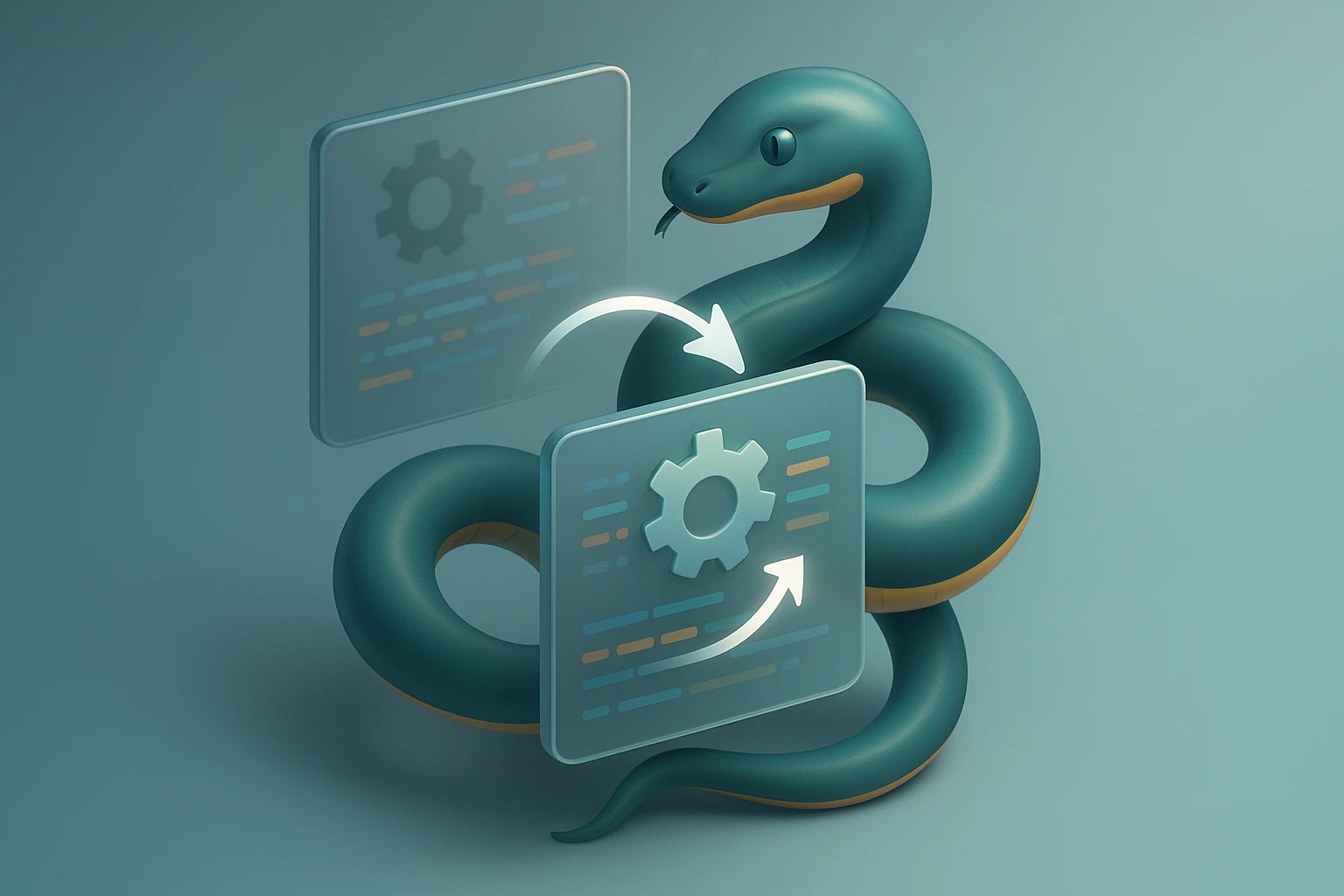Introduction to Object-Oriented Programming in Python
Intro to Object-Oriented Programming in Python: simple diagram showing classes, objects, inheritance arrows, methods, attributes, code snippets and a Python logo unifying concepts.

Sponsor message — This article is made possible by Dargslan.com, a publisher of practical, no-fluff IT & developer workbooks.
Why Dargslan.com?
If you prefer doing over endless theory, Dargslan’s titles are built for you. Every workbook focuses on skills you can apply the same day—server hardening, Linux one-liners, PowerShell for admins, Python automation, cloud basics, and more.
Why Understanding Object-Oriented Programming Matters for Your Python Journey
Every developer reaches a point where writing simple scripts no longer suffices. Your code grows longer, becomes harder to maintain, and debugging turns into a nightmare of scrolling through endless functions. This is precisely where object-oriented programming becomes not just useful, but essential. Understanding OOP transforms how you think about code organization, allowing you to build applications that are scalable, maintainable, and mirror real-world structures in ways that procedural programming simply cannot achieve.
Object-oriented programming represents a programming paradigm that organizes code around objects rather than functions and logic. These objects combine data and the methods that operate on that data into cohesive units. This approach offers multiple perspectives: from the architectural viewpoint, it provides structure; from the maintenance angle, it offers clarity; and from the collaboration standpoint, it enables teams to work on different components simultaneously without stepping on each other's toes.
Throughout this comprehensive guide, you'll discover the fundamental building blocks of OOP in Python, understand how classes and objects work together, explore inheritance and polymorphism, and learn practical applications that you can implement immediately in your projects. Whether you're transitioning from procedural programming or starting fresh, this exploration will equip you with the knowledge to write more professional, organized, and effective Python code.
The Foundation: Classes and Objects
At the heart of object-oriented programming lies the relationship between classes and objects. A class serves as a blueprint or template that defines the structure and behavior of objects, while an object represents a specific instance created from that class. Think of a class as an architectural plan for a house, and objects as the actual houses built from those plans—each house follows the same blueprint but can have different colors, furniture, and inhabitants.
When you define a class in Python, you're essentially creating a new data type with its own attributes (data) and methods (functions). This encapsulation of related data and functionality into a single unit represents one of OOP's most powerful concepts. The syntax for creating a class begins with the class keyword, followed by the class name (conventionally using CamelCase), and a colon.
class Vehicle:
def __init__(self, brand, model, year):
self.brand = brand
self.model = model
self.year = year
def display_info(self):
return f"{self.year} {self.brand} {self.model}"
my_car = Vehicle("Toyota", "Camry", 2022)
print(my_car.display_info())The __init__ method serves as the constructor, automatically called when creating a new object. The self parameter references the instance itself, allowing you to access and modify the object's attributes. This mechanism enables each object to maintain its own state independently from other objects created from the same class.
"The beauty of object-oriented programming lies not in the code you write, but in the mental models it allows you to construct, turning abstract concepts into tangible, manipulable entities."
Attributes: Instance vs Class Variables
Python distinguishes between two types of attributes within classes. Instance attributes belong to individual objects and are typically defined within the __init__ method using self. Each object maintains its own copy of these attributes, allowing different objects to have different values. Class attributes, conversely, are shared across all instances of the class and are defined directly within the class body, outside any methods.
class BankAccount:
interest_rate = 0.03 # Class attribute
def __init__(self, owner, balance):
self.owner = owner # Instance attribute
self.balance = balance # Instance attribute
def apply_interest(self):
self.balance += self.balance * BankAccount.interest_rateThis distinction becomes particularly important when you need to track information relevant to all instances versus data specific to individual objects. Class attributes work perfectly for constants, default values, or counters tracking the total number of instances created.
Encapsulation: Protecting Your Data
Encapsulation represents the practice of bundling data with the methods that operate on that data while restricting direct access to some of the object's components. This principle prevents external code from directly manipulating an object's internal state, instead requiring interaction through defined interfaces. Python implements encapsulation through naming conventions rather than strict access modifiers found in languages like Java or C++.
Python uses a system of name mangling to indicate different levels of attribute visibility:
- Public attributes have no leading underscores and can be accessed from anywhere
- Protected attributes start with a single underscore (_attribute) and signal that they're intended for internal use
- Private attributes begin with double underscores (__attribute) and trigger name mangling to prevent accidental access
class SecureAccount:
def __init__(self, account_number, pin):
self.account_number = account_number # Public
self._balance = 0 # Protected
self.__pin = pin # Private
def verify_pin(self, entered_pin):
return self.__pin == entered_pin
def deposit(self, amount):
if amount > 0:
self._balance += amount
return True
return False
def get_balance(self):
return self._balanceWhile Python doesn't enforce true privacy, these conventions communicate intent to other developers. The double underscore prefix transforms __pin into _SecureAccount__pin internally, making accidental access less likely while still allowing intentional access if absolutely necessary.
"Encapsulation isn't about building walls around your data; it's about creating well-defined doorways that control how that data flows in and out of your objects."
Properties and Getters/Setters
Python's @property decorator provides an elegant way to implement getters and setters without sacrificing the simplicity of attribute access. This approach allows you to add validation logic, computed attributes, or side effects while maintaining clean syntax for users of your class.
class Temperature:
def __init__(self, celsius):
self._celsius = celsius
@property
def celsius(self):
return self._celsius
@celsius.setter
def celsius(self, value):
if value < -273.15:
raise ValueError("Temperature below absolute zero!")
self._celsius = value
@property
def fahrenheit(self):
return (self._celsius * 9/5) + 32
@fahrenheit.setter
def fahrenheit(self, value):
self.celsius = (value - 32) * 5/9This pattern enables you to start with simple public attributes and later add validation or computation without breaking existing code that uses your class. The property decorator transforms method calls into attribute access, maintaining Python's philosophy of simplicity and readability.
Inheritance: Building on Existing Foundations
Inheritance allows you to create new classes based on existing ones, inheriting their attributes and methods while adding or modifying functionality. This mechanism promotes code reuse and establishes hierarchical relationships between classes that mirror real-world taxonomies. The parent class (also called base class or superclass) provides the foundation, while child classes (derived classes or subclasses) extend or specialize that foundation.
| Inheritance Type | Description | Use Case |
|---|---|---|
| Single Inheritance | A child class inherits from one parent class | Most common scenario, clear hierarchies |
| Multiple Inheritance | A child class inherits from multiple parent classes | Mixing capabilities from different sources |
| Multilevel Inheritance | A chain of inheritance (grandparent → parent → child) | Increasingly specialized classes |
| Hierarchical Inheritance | Multiple child classes inherit from one parent | Different specializations of same concept |
class Animal:
def __init__(self, name, age):
self.name = name
self.age = age
def make_sound(self):
return "Some generic sound"
def info(self):
return f"{self.name} is {self.age} years old"
class Dog(Animal):
def __init__(self, name, age, breed):
super().__init__(name, age)
self.breed = breed
def make_sound(self):
return "Woof!"
def fetch(self):
return f"{self.name} is fetching the ball"
class Cat(Animal):
def make_sound(self):
return "Meow!"
def scratch(self):
return f"{self.name} is scratching the furniture"The super() function provides access to methods from the parent class, enabling you to extend rather than completely replace inherited functionality. This becomes particularly valuable when you want to add additional behavior while maintaining the parent class's logic.
"Inheritance creates relationships between classes that reflect how we naturally categorize the world, allowing code to mirror the conceptual structures we use to understand complex systems."
Method Resolution Order and Multiple Inheritance
When a class inherits from multiple parents, Python uses the Method Resolution Order (MRO) to determine which method to call when multiple parents define the same method. Python employs the C3 linearization algorithm to create a consistent order that respects the inheritance hierarchy while avoiding ambiguity.
class Flyer:
def move(self):
return "Flying through the air"
class Swimmer:
def move(self):
return "Swimming through water"
class Duck(Flyer, Swimmer):
def quack(self):
return "Quack!"
donald = Duck()
print(donald.move()) # Output: "Flying through the air"
print(Duck.__mro__) # Shows the method resolution orderThe MRO follows the order in which parent classes are listed, moving from left to right and then up the hierarchy. You can view any class's MRO using the __mro__ attribute or the mro() method, which proves invaluable when debugging complex inheritance structures.
Polymorphism: One Interface, Many Implementations
Polymorphism enables objects of different classes to be treated through a common interface, with each class providing its own implementation of that interface. This concept allows you to write more flexible and maintainable code by programming to interfaces rather than concrete implementations. Python's duck typing philosophy ("if it walks like a duck and quacks like a duck, it's a duck") makes polymorphism particularly natural and powerful.
Python supports several forms of polymorphism:
- 🎭 Method Overriding: Child classes provide specific implementations of methods defined in parent classes
- 🔄 Operator Overloading: Custom classes define behavior for built-in operators like +, -, *, ==
- 📞 Duck Typing: Objects are evaluated based on their methods and properties rather than their type
- 🎨 Abstract Base Classes: Formal interfaces that define required methods without implementation
from abc import ABC, abstractmethod
class Shape(ABC):
@abstractmethod
def area(self):
pass
@abstractmethod
def perimeter(self):
pass
class Rectangle(Shape):
def __init__(self, width, height):
self.width = width
self.height = height
def area(self):
return self.width * self.height
def perimeter(self):
return 2 * (self.width + self.height)
class Circle(Shape):
def __init__(self, radius):
self.radius = radius
def area(self):
return 3.14159 * self.radius ** 2
def perimeter(self):
return 2 * 3.14159 * self.radius
def print_shape_info(shape):
print(f"Area: {shape.area()}")
print(f"Perimeter: {shape.perimeter()}")The print_shape_info function works with any object that implements the area() and perimeter() methods, regardless of its specific class. This flexibility allows you to add new shape types without modifying existing code that uses shapes.
"Polymorphism transforms rigid, brittle code into flexible systems that adapt to new requirements without breaking existing functionality, embodying the open-closed principle at its finest."
Magic Methods and Operator Overloading
Python's magic methods (also called dunder methods, from "double underscore") allow you to define how your objects behave with built-in operations. These special methods, surrounded by double underscores, enable your custom classes to integrate seamlessly with Python's syntax and built-in functions.
class Vector:
def __init__(self, x, y):
self.x = x
self.y = y
def __add__(self, other):
return Vector(self.x + other.x, self.y + other.y)
def __mul__(self, scalar):
return Vector(self.x * scalar, self.y * scalar)
def __str__(self):
return f"Vector({self.x}, {self.y})"
def __repr__(self):
return f"Vector({self.x}, {self.y})"
def __eq__(self, other):
return self.x == other.x and self.y == other.y
def __len__(self):
return int((self.x**2 + self.y**2)**0.5)These magic methods make your custom objects feel like native Python types. The __str__ method controls how print() displays your object, __eq__ defines equality comparison, and __add__ enables the + operator to work with your class.
Composition: An Alternative to Inheritance
While inheritance creates "is-a" relationships, composition establishes "has-a" relationships by including instances of other classes as attributes. This approach often provides greater flexibility than inheritance, allowing you to change behavior at runtime and avoid the fragility of deep inheritance hierarchies. Composition adheres to the principle of "favor composition over inheritance" advocated by many design patterns.
class Engine:
def __init__(self, horsepower, fuel_type):
self.horsepower = horsepower
self.fuel_type = fuel_type
def start(self):
return f"Engine starting: {self.horsepower}hp {self.fuel_type} engine"
class Transmission:
def __init__(self, transmission_type):
self.type = transmission_type
def shift(self, gear):
return f"Shifting {self.type} transmission to gear {gear}"
class Car:
def __init__(self, make, model, engine, transmission):
self.make = make
self.model = model
self.engine = engine # Composition
self.transmission = transmission # Composition
def start(self):
return self.engine.start()
def drive(self):
return f"{self.make} {self.model} is driving"This design allows you to create cars with different combinations of engines and transmissions without creating a separate subclass for each combination. You can easily swap components, test individual parts in isolation, and reuse components across different vehicle types.
| Aspect | Inheritance | Composition |
|---|---|---|
| Relationship | "is-a" relationship | "has-a" relationship |
| Flexibility | Fixed at class definition | Can change at runtime |
| Coupling | Tight coupling to parent | Loose coupling between components |
| Code Reuse | Through inheritance hierarchy | Through object inclusion |
| Testing | Must test with parent context | Components testable independently |
"The choice between inheritance and composition isn't about which is better, but about which more accurately models the relationships in your problem domain while maintaining flexibility for future changes."
Class Methods and Static Methods
Beyond regular instance methods, Python provides two additional method types that serve different purposes. Class methods receive the class itself as their first argument (conventionally named cls) and can access or modify class state. Static methods belong to the class namespace but don't receive any implicit first argument, functioning like regular functions that happen to be organized within a class.
class Employee:
company_name = "TechCorp"
employee_count = 0
def __init__(self, name, salary):
self.name = name
self.salary = salary
Employee.employee_count += 1
@classmethod
def from_string(cls, employee_string):
name, salary = employee_string.split('-')
return cls(name, int(salary))
@classmethod
def change_company_name(cls, new_name):
cls.company_name = new_name
@staticmethod
def is_workday(day):
return day not in ['Saturday', 'Sunday']
def give_raise(self, amount):
self.salary += amountClass methods work perfectly as alternative constructors, allowing you to create instances from different data formats. The from_string method demonstrates this pattern, parsing a string and returning a new Employee instance. Static methods provide utility functions related to the class but not dependent on instance or class state.
When to Use Each Method Type
Choosing the appropriate method type depends on what data the method needs to access:
- Use instance methods when you need to access or modify instance-specific data
- Use class methods when you need to access or modify class-level data, or when creating alternative constructors
- Use static methods when the method doesn't need access to instance or class data but logically belongs with the class
This distinction helps organize your code logically and signals to other developers what dependencies each method has. Instance methods can access everything, class methods can access class attributes and call other class methods, while static methods operate independently.
Special Attributes and Introspection
Python provides numerous special attributes that expose information about classes and objects, enabling powerful introspection capabilities. These attributes, typically surrounded by double underscores, allow you to examine and manipulate objects dynamically at runtime.
class Product:
"""A class representing a product in inventory"""
def __init__(self, name, price):
self.name = name
self.price = price
# Special attributes
print(Product.__name__) # Class name: "Product"
print(Product.__doc__) # Docstring
print(Product.__module__) # Module name
print(Product.__bases__) # Parent classes
product = Product("Laptop", 999)
print(product.__class__) # Class of the instance
print(product.__dict__) # Instance attributes as dictionary
print(hasattr(product, 'name')) # Check attribute existence
print(getattr(product, 'price', 0)) # Get attribute with default
setattr(product, 'quantity', 10) # Set attribute dynamicallyThese introspection capabilities enable you to build flexible frameworks, implement serialization systems, create debugging tools, and write code that adapts to the objects it receives. The __dict__ attribute proves particularly useful for understanding what data an object contains.
Design Patterns and Best Practices
Object-oriented programming shines brightest when combined with established design patterns that solve common problems. Understanding these patterns helps you write more maintainable, scalable code that other developers can easily understand and extend.
The Singleton Pattern
Sometimes you need exactly one instance of a class throughout your application. The Singleton pattern ensures this constraint while providing global access to that instance.
class DatabaseConnection:
_instance = None
def __new__(cls):
if cls._instance is None:
cls._instance = super().__new__(cls)
cls._instance.connected = False
return cls._instance
def connect(self):
if not self.connected:
# Actual connection logic here
self.connected = True
return "Connected to database"
return "Already connected"
# Both variables reference the same instance
db1 = DatabaseConnection()
db2 = DatabaseConnection()
print(db1 is db2) # TrueThe Factory Pattern
Factory patterns delegate object creation to specialized methods or classes, providing flexibility in what types of objects get created based on input parameters or configuration.
class Animal:
def speak(self):
pass
class Dog(Animal):
def speak(self):
return "Woof!"
class Cat(Animal):
def speak(self):
return "Meow!"
class AnimalFactory:
@staticmethod
def create_animal(animal_type):
animals = {
'dog': Dog,
'cat': Cat
}
animal_class = animals.get(animal_type.lower())
if animal_class:
return animal_class()
raise ValueError(f"Unknown animal type: {animal_type}")
# Using the factory
pet = AnimalFactory.create_animal('dog')
print(pet.speak())"Design patterns aren't about memorizing solutions; they're about recognizing recurring problems and applying proven approaches that generations of developers have refined through experience."
SOLID Principles in Python
The SOLID principles provide guidelines for writing maintainable object-oriented code:
- 💎 Single Responsibility: Each class should have one reason to change, handling one specific aspect of functionality
- 🔓 Open/Closed: Classes should be open for extension but closed for modification, achieved through inheritance and composition
- 🔄 Liskov Substitution: Subclasses should be substitutable for their parent classes without breaking functionality
- 🎯 Interface Segregation: Clients shouldn't depend on interfaces they don't use; prefer smaller, focused interfaces
- ⬇️ Dependency Inversion: Depend on abstractions rather than concrete implementations
Applying these principles leads to code that's easier to test, maintain, and extend. While Python's dynamic nature means you don't need to follow these as rigidly as in statically-typed languages, they still provide valuable guidance for structuring your classes and modules.
Practical Applications and Real-World Examples
Understanding theory matters, but seeing how OOP solves real problems cements that knowledge. Consider a practical example of building a simple game character system that demonstrates multiple OOP concepts working together.
from abc import ABC, abstractmethod
class Character(ABC):
def __init__(self, name, health, attack_power):
self._name = name
self._health = health
self._max_health = health
self._attack_power = attack_power
self._inventory = []
@property
def name(self):
return self._name
@property
def health(self):
return self._health
@property
def is_alive(self):
return self._health > 0
@abstractmethod
def special_ability(self):
pass
def take_damage(self, amount):
self._health = max(0, self._health - amount)
return f"{self._name} took {amount} damage. Health: {self._health}/{self._max_health}"
def heal(self, amount):
self._health = min(self._max_health, self._health + amount)
return f"{self._name} healed {amount}. Health: {self._health}/{self._max_health}"
def attack(self, target):
if not self.is_alive:
return f"{self._name} is defeated and cannot attack"
return target.take_damage(self._attack_power)
def add_item(self, item):
self._inventory.append(item)
class Warrior(Character):
def __init__(self, name):
super().__init__(name, health=150, attack_power=25)
self._armor = 10
def special_ability(self):
return f"{self.name} uses Shield Bash!"
def take_damage(self, amount):
reduced_damage = max(1, amount - self._armor)
return super().take_damage(reduced_damage)
class Mage(Character):
def __init__(self, name):
super().__init__(name, health=80, attack_power=35)
self._mana = 100
def special_ability(self):
if self._mana >= 30:
self._mana -= 30
return f"{self.name} casts Fireball! Mana: {self._mana}"
return f"{self.name} doesn't have enough mana"
class Healer(Character):
def __init__(self, name):
super().__init__(name, health=100, attack_power=15)
def special_ability(self):
return f"{self.name} casts Healing Light!"
def heal_ally(self, target):
return target.heal(30)This example demonstrates inheritance (character types extending the base Character class), encapsulation (protected attributes with property decorators), abstraction (the abstract special_ability method), and polymorphism (each character type implements special_ability differently). The system remains extensible—adding new character types requires only creating a new subclass.
Common Pitfalls and How to Avoid Them
Even experienced developers encounter challenges when working with object-oriented programming. Recognizing these common mistakes helps you avoid them in your own code.
Mutable Default Arguments
One of Python's most notorious gotchas involves using mutable objects as default parameter values. The default value gets created once when the function is defined, not each time it's called.
# Wrong approach
class ShoppingCart:
def __init__(self, items=[]):
self.items = items # Danger! Shared across instances
# Correct approach
class ShoppingCart:
def __init__(self, items=None):
self.items = items if items is not None else []Modifying Class Attributes Through Instances
When you assign to an attribute through an instance, Python creates a new instance attribute that shadows the class attribute rather than modifying the class attribute itself.
class Counter:
count = 0 # Class attribute
def increment(self):
self.count += 1 # Creates instance attribute!
# Should be: Counter.count += 1Circular Imports
When classes in different modules reference each other, you can create circular import dependencies. Structure your code to minimize dependencies, use dependency injection, or employ techniques like importing within functions when necessary.
Deep Inheritance Hierarchies
Inheritance hierarchies more than three or four levels deep become difficult to understand and maintain. Consider using composition or interfaces instead of creating elaborate inheritance trees.
Testing Object-Oriented Code
Well-designed object-oriented code naturally lends itself to testing. Each class represents a unit that can be tested independently, and proper encapsulation ensures that tests focus on behavior rather than implementation details.
import unittest
class TestCharacter(unittest.TestCase):
def setUp(self):
self.warrior = Warrior("TestWarrior")
self.mage = Mage("TestMage")
def test_initial_health(self):
self.assertEqual(self.warrior.health, 150)
self.assertEqual(self.mage.health, 80)
def test_take_damage(self):
self.warrior.take_damage(30)
self.assertEqual(self.warrior.health, 130)
def test_character_death(self):
self.mage.take_damage(100)
self.assertFalse(self.mage.is_alive)
def test_cannot_attack_when_dead(self):
self.mage.take_damage(100)
result = self.mage.attack(self.warrior)
self.assertIn("defeated", result)Testing object-oriented code benefits from techniques like dependency injection, where you pass dependencies to objects rather than having them create their own. This approach allows you to substitute mock objects during testing, isolating the class under test from its dependencies.
Performance Considerations
While object-oriented programming provides organizational benefits, it does introduce some overhead compared to procedural code. Understanding these performance implications helps you make informed decisions about when and how to use OOP features.
Creating objects involves memory allocation and initialization overhead. For performance-critical code processing millions of objects, consider using __slots__ to reduce memory usage and improve attribute access speed.
class OptimizedPoint:
__slots__ = ['x', 'y'] # Restricts attributes, saves memory
def __init__(self, x, y):
self.x = x
self.y = yThe __slots__ declaration prevents Python from creating a __dict__ for each instance, reducing memory overhead by about 40-50% for simple objects. However, this optimization comes with trade-offs: you cannot add attributes dynamically, and inheritance becomes more complex.
Method calls in Python carry slightly more overhead than function calls due to the need to bind the method to the instance. For extremely performance-sensitive code, consider whether the organizational benefits of methods outweigh this minimal cost, or use profiling tools to identify actual bottlenecks rather than optimizing prematurely.
What's the difference between a class and an object in Python?
A class serves as a blueprint or template that defines the structure and behavior of objects, specifying what attributes and methods objects of that type will have. An object is a specific instance created from that class, containing actual data and able to perform the actions defined by the class. Think of a class as a cookie cutter and objects as the individual cookies made with that cutter—the cutter defines the shape, but each cookie is a separate entity.
When should I use inheritance versus composition?
Use inheritance when you have a clear "is-a" relationship and the child class truly represents a specialized version of the parent class. Use composition when you have a "has-a" relationship or when you want more flexibility to change behavior at runtime. Composition generally provides better flexibility and testability, so favor composition over inheritance unless inheritance clearly models your domain better. If you find yourself creating deep inheritance hierarchies (more than 3-4 levels), composition is almost certainly the better choice.
What are magic methods and why are they important?
Magic methods (dunder methods) are special methods surrounded by double underscores that Python calls automatically in response to certain operations. They allow your custom classes to integrate seamlessly with Python's built-in syntax and functions. For example, __init__ initializes new objects, __str__ controls how objects are printed, __add__ enables the + operator, and __len__ allows the len() function to work with your objects. They're important because they make your custom classes feel like native Python types.
How does Python's approach to encapsulation differ from other languages?
Python uses naming conventions rather than strict access modifiers to indicate intended visibility. Single underscore (_attribute) suggests protected/internal use, double underscore (__attribute) triggers name mangling for stronger privacy, but neither actually prevents access if someone really wants it. This reflects Python's philosophy of "we're all consenting adults here"—the language trusts developers to respect intended interfaces rather than enforcing them. Other languages like Java or C++ use keywords (private, protected, public) that the compiler enforces strictly.
What's the Method Resolution Order and why does it matter?
The Method Resolution Order (MRO) determines which method gets called when a class inherits from multiple parent classes that define the same method. Python uses the C3 linearization algorithm to create a consistent, predictable order that respects the inheritance hierarchy. This matters because it prevents ambiguity in multiple inheritance scenarios and ensures that method calls behave consistently. You can view a class's MRO using the __mro__ attribute or mro() method, which is invaluable when debugging complex inheritance structures.
Should I always use OOP in Python?
No, object-oriented programming is a tool, not a requirement. Python supports multiple paradigms, and sometimes procedural or functional approaches work better. Use OOP when you're modeling entities with state and behavior, building systems that need to scale and be maintained by teams, or when you need inheritance and polymorphism. For simple scripts, data processing pipelines, or mathematical computations, procedural or functional approaches might be clearer and more appropriate. Choose the paradigm that best fits your specific problem.




